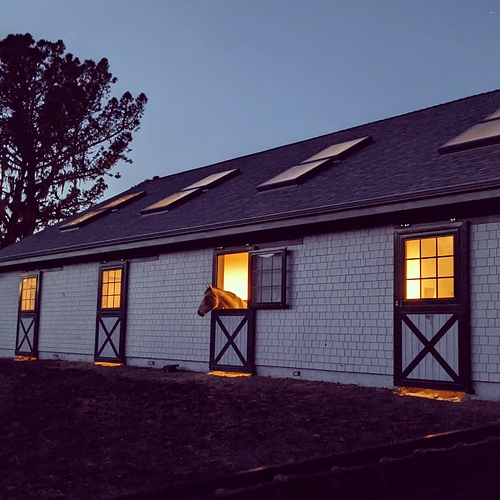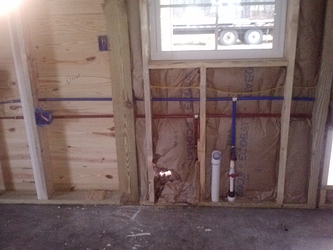Agree. When I built my barn I didn’t do the overhang and had it added a year later, which cost a lot more than if I’d done it to start. My stalls opened to attached runs and I kept the doors open almost all year except in a blizzard. Once the overhang was added snow rarely blew in, and it was so much cooler in the summer.
It’ll be open behind the wash stall with a full-width sliding door, definitely maximizing the air flow. I’m planning for the wash stall to be my primary cross-tie spot, so the door will snug up the space a bit if needed when the farrier/vet is out.
I am wondering why you chose a double door for your tack room. A 4 foot door opening towards the left-hand wall would have been my choice.
Regarding the bathroom: I have a new (we built it in 2021) 5 stall barn at my house. We debated adding the bathroom and didn’t, and I really regret it. Now every time someone needs to use the bathroom I’m letting them into the house, which is a huge hassle with our GSD that doesn’t like strangers. I’d even use the bathroom in the barn regularly as I’m out there for hours most days. Maybe it’s a different situation for me because I’m training out of the barn instead of there for chores and riding one horse a few days a week.
@trubandloki they are from Lucas Equine in Kentucky (https://www.lucasequine.com/photo_gallery_view.php?id=8). You can get them with any type of window - I almost did drop down (this is plexiglass) instead of to the side but I didn’t like the kick risk since the doors open to the pasture. Fwiw I’d 100% work with them again (and I will be). They were great and custom built some difficult stall fronts for me.
That’s one option. Another is to have the whole thing slope slightly to the back. But in use, we found that water goes EVERYWHERE. And the surface below the wash stall settled over 20 years. Not badly, but we sometimes have to sweep water back from the entry to the wash stall. And I think you know this, but don’t just have one light source above the horse if it’s your crosstie area. All of the lights don’t need to be in use all of the time, but recognize that there will be a dark region caused by the shade of the horse’s body. Think about your vet having to suture a low leg wound on a dark, cold night. At least have a GFI plug that accessory lighting can be plugged into, or radiography equipment or whatever. (I’m tossing in all of my thoughts in case someone is reading this thread for educational purposes.)
I suggested a bathroom cause I’m a middle aged women that pees all the time. I drink a ton of water. I use it 3-4 times a day.
My farrier, vet, hay delivery folks love my air conditioned and heated bathroom stocked with supplies. Cost me 1200.00 for the sewer and another 1000.00 for everything else to build it out.
Worth every penny.
Honestly, the aesthetics of the double door is what I’m going for
OP mentioned they already have an outside bathroom in the nearby shop barn, don’t really need one in the horse barn itself.
Neat windows those in the picture.
Our wash room drains to the back and outside right thru the bottom of the wall and into a French drain.
We love that, no drain necessary at all.
There are aesthetics to a double door?
You must be picturing something different than what I am thinking of.
Please share.
Exterior patio doors
edited to fix the link
Not helpful for people with large operations and frequent visitors. For years, I’ve used a lugga-loo in my tractor shed barn. Basically a 5gal bucket with a plastic toilet lid. It sits in the tack room. No liner (unless I’m traveling with horses), one cup of pellet bedding per use. No.1 only. I dump it into the manure pile and compost it. When traveling it’s in the LQ/dressing room, no need for public toilets. Yay!
Something I feel pretty acutely in my tack room is the need for wall space. Space to hang saddle racks, bridles, blankets, other equipment. Floor space against the wall to store trunks or other storage type containers. Space for the barn cat’s bed and box. It’s amazing how much stuff there is, even with a lot of seasonal or not used very often things in a different space. Windows also limit how that wall space can be used, and while I wouldn’t give up my exterior window, sometimes I do eyeball that wall space it takes up and wish it were a different size or sited differently.
But taking up some of that wall space for an extra door could really be limiting, especially if those doors open inward (which they probably should) and even more especially if you want the space behind them clear so you can open them back against the wall.
Just one thing to consider!
The vet we used in Ocala used to come to our barn to use our bathroom at least once a month. We would see him drive up the driveway like the devil was chasing him! He would drive right into the barn and run to the potty. 
On the subject of bathrooms in the barn. I have only worked at one barn that did NOT have a toilet. One barn had a port o potty and all of the others, up and down the east coast all had a toilet and they were all privately owned farms with the exception of one boarding barn.
We had similar doors at a barn I boarded at except the top was solid instead of plexiglass. The stalls opened to small pens that were meant for medical use not regular use.
They were a bit annoying because once the the top is latched back you can’t slide the door open. So there was a lot of walking to the end of the barn aisle and around the outside (and climbing between the pen fences) to open and close the tops or slide open the doors if the tops were latched open. This may or may not annoy you depending on how often you expect to be opening doors.
What worked at a different facility was full sized sliding doors (bars and plexiglass on top) with an interior metal stall gate on hinges. The door could be opened for air flow or closed for warmth and you could go in and out the stall gate without worrying about latching Dutch doors.
These doors can be slid open with the windows open or closed, you can also open and close the window from inside or outside the stall, you just have to open the door a crack to latch it if you’re inside, the window latch is located on the outside. The door itself has a gravity latch and can be opened and closed and latched from inside or outside the stall.
That sounds like a much better design. Something to look out for if someone wants to purchase them - be aware of the specific design.
Absolutely. When selecting vendors for your barn, whether it be a GC, architect, or materials supplier, working with people that are intimately familiar with the daily routine of a barn is crucial. Lucas equine is a team of horse owners and it really shows in their designs and craftsmanship. (not an ad, I just really love them  ) When you are able to choose vendors that are familiar with horses, you can usually trust that the design will be safe and practical. If you are limited to people that have minimal experience with horses, you have to pay much more attention to how things are designed and built.
) When you are able to choose vendors that are familiar with horses, you can usually trust that the design will be safe and practical. If you are limited to people that have minimal experience with horses, you have to pay much more attention to how things are designed and built.
What is the plan for heating and cooling the tack room?
After three decades of boarding places with no heat and no AC and fighting moldy and mildewed tack and boots, I have spent the past ten years mildew-free. Before I built my barn I read that museums store and exhibit leather items in spaces with humidity controlled between 30 and 70 percent to reduce excessive leather drying on the low end and mold and mildew on the high end. I keep a humidity meter displayed prominently in my tack room and adjust the heat and AC whenever needed to maintain that range.
If you’re going with climate control make sure you have the tack room walls and ceiling insulated during construction and pick insulating glass for your door and windows.
And off again to another suggestion. Anywhere you will have closed up walls take and file away pictures of the wiring and piping in them before they are closed up. Sometime later you will find knowing what is behind the walls and locations to be very useful.
Do this, too, with where your water & power to the barn is buried!
Two really good suggestions about taking pictures and marking locations of pipes.
Speaking of inside of walls, think of where you might want to mount things in finished spaces (with sheet rock) and have your contractor install 3/4 in or 1-in plywood on the entire wall, that way you are never searching for studs to hang hooks or saddle racks, etc


